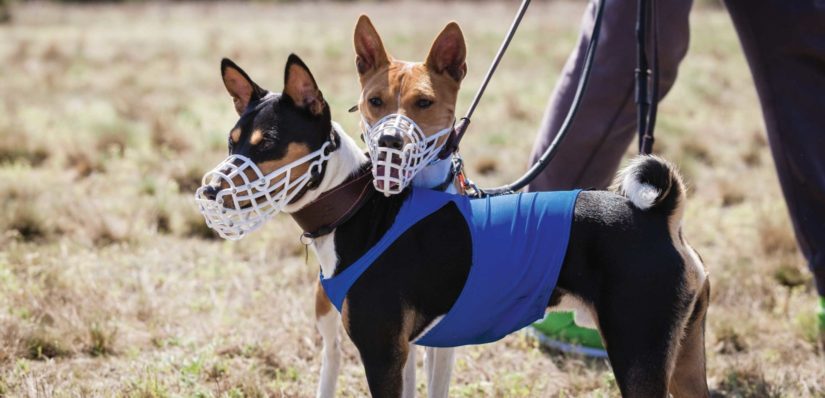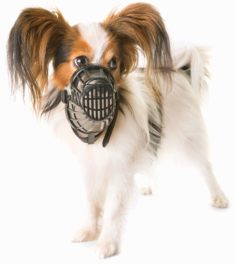Muzzles are an often misunderstood tool for keeping your dog safe.
In the past, dogs wearing muzzles were often labeled as ‘bad’ or ‘aggressive’ and were scary for some people. Today we know that pet guardians muzzle their dogs for a variety of reasons, intended to keep their animals safe and happy.

What is a muzzle?
A muzzle is a piece of equipment worn over the snout of a dog to prevent them from biting or scavenging food or other objects from the ground.
Do dogs mind wearing muzzles?
No. Muzzles are not painful, although they can limit mobility of the mouth and feel strange on a dog’s face at first.
Some dogs may have a negative emotional response to them if they have been used to restrain them in the past for a procedure (e.g. grooming or nail trims) but all dogs can be trained to love wearing a muzzle.
When should I use a muzzle on my dog?
- If your dog is at risk of biting someone or another animal.
- If an animal control bylaw mandates your dog or breed must wear a muzzle.
- If your dog continuously scavenges objects from the ground.
- Your dog is at the groomer or veterinarian and may bite because he is frightened.
- You are working on training and need to keep everyone safe.
Recommended muzzles
Choose a muzzle that is designed for the specific purpose you need and make sure the muzzles is suited for your dog’s breed and size.
For training & walking

Basket muzzles (rubber, plastic or metal) allow your dog to drink water, pant to cool down and, while they may look scary, they are the most humane choice.
For veterinary use
Exams and grooming (short-term use)

Soft flat muzzles made of mesh, nylon, fabric or leather prevent a dog from panting. Panting is the way dogs cool down (a dog’s
way of sweating). Use these for short term
procedures only.
Note: Dogs cannot cool off by panting when wearing soft muzzles.
 How to fit your dog for a muzzle
How to fit your dog for a muzzle
The muzzle should be:
- Snug, but not tight
- Allow the dog to open his mouth, but not all the way
- Adjustable
Muzzle companies have guidelines for sizing muzzles, based on breed and size of dog. Visit your local pet store and ask for assistance in finding the right fit for your dog.
*Important to note
- Even when your dog is comfortable wearing a muzzle be must still be aware of triggers that frighten them. Having a muzzle doesn’t mean people, places or other dogs aren’t still scary – better to avoid the situations altogether even with the safety of a muzzle.
- Don’t leave the muzzle on all day or use it as the only way to deal with behaviours. Do not use a muzzle to stop a dog from barking.
- Look for an AnimalKind accredited trainer to help you with training issues. The program provides SPCA-developed standards for positive, humane training.
Muzzle training
Step 1: Teach your dog that the muzzle = yummy treat
Show your dog the muzzle, say “yes”, and give him a treat. Every time you show him the muzzle, give a treat.
If your dog is uncomfortable or afraid of muzzle:
- Put it on table away from him and feed him on other side of room.
- Keep it at a distance where he’ll eat treats when it is in site.
- Practice this and move muzzle closer without causing him to leave room.
The goal: Your dog will look at the muzzle and then to you for a treat.
Step 2: Teach your dog to wear a muzzle
Follow the outlined training plan to teach your dog to enjoy wearing a muzzle when he goes out on walks and when visitors come to your home.
Work in three-minute sessions. Do not move to the next step until dog shows a happy response to the previous step.
Training plan
Step 1:
Show your dog the muzzle – then give him high value treats or play a game of fetch.
Step 2:
Clip muzzle around neck without putting it on nose. Then give high value treats in playful manner, toss them from side to side.
Step 3:
Put food into muzzle (cup hand so that food does not fall out). Gently move muzzle away from dog’s nose as they are eating from it. Allow dog to put his nose into muzzle, do not put muzzle onto dog.
Step 4:
Increase duration of nose in muzzle (use squeeze cheese or cheese whiz).
Step 5:
Begin to add straps around neck while dog has nose in muzzle – do not attach them at this stage.
Step 6:
Loosely attach straps around neck. Use squeeze cheese or special treat.
Note: If your dog tries to paw at muzzle to remove it DO NOT remove it at this time. Distract him by asking for some behaviors that he enjoys doing like sit or down. Remove muzzle when he is no longer trying to remove it. If dog constantly tries to remove muzzle repeat some earlier steps to ensure he enjoys the muzzle before moving on.
*Training plan transcribed by Sarah Pennington based on Chirag Patel’s video “Teach your dog to love wearing a muzzle”
Download “How to use a dog muzzle” information pamphlet (PDF).

